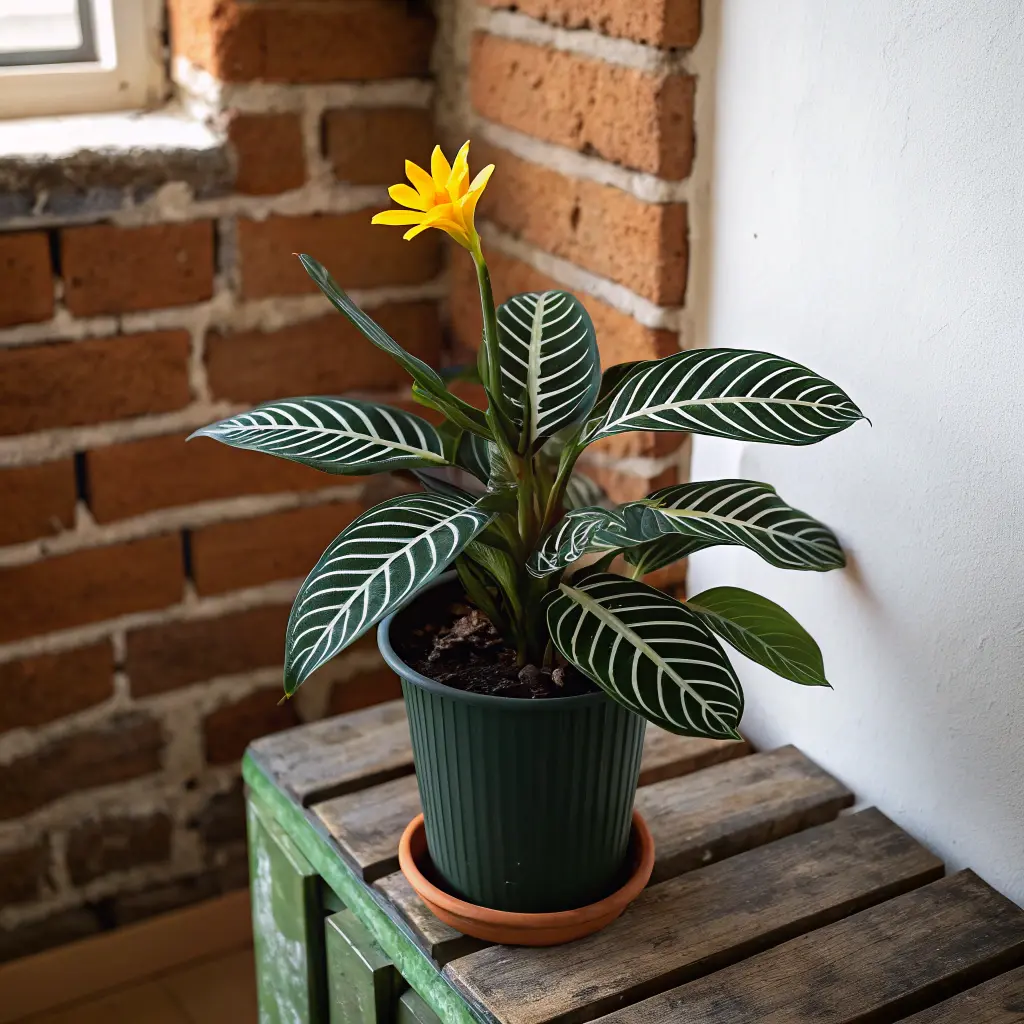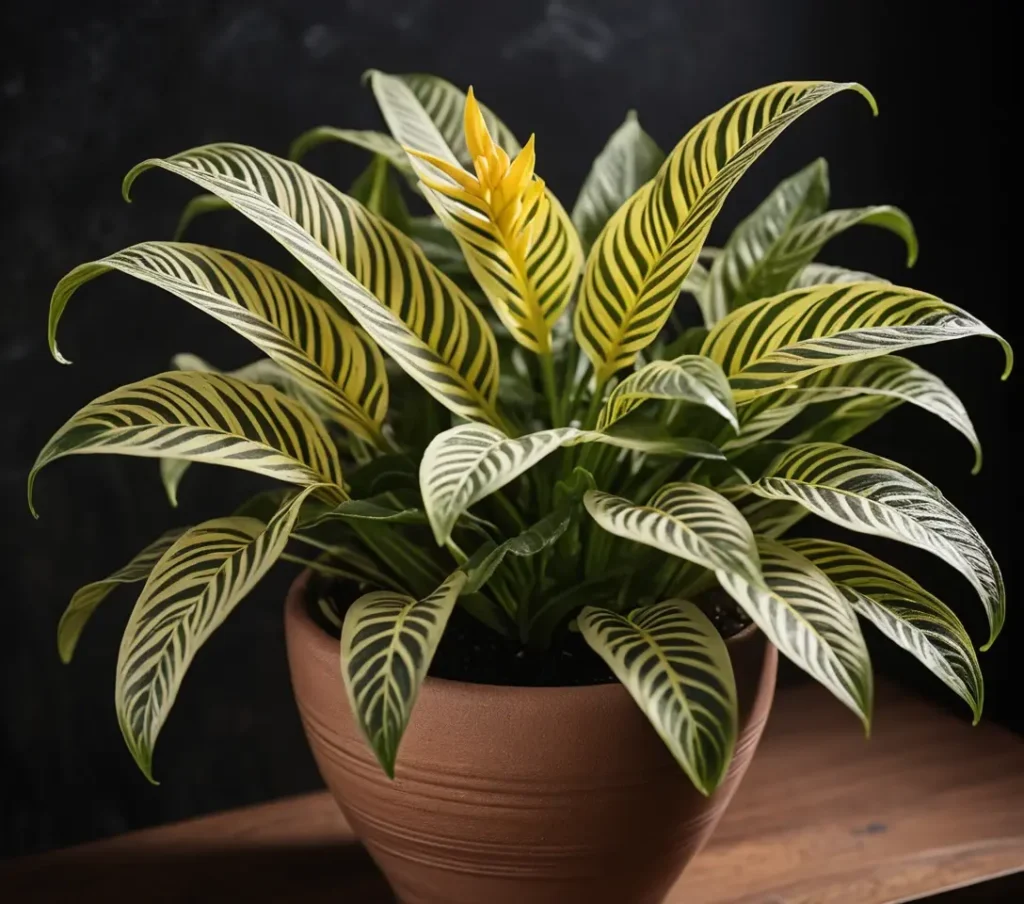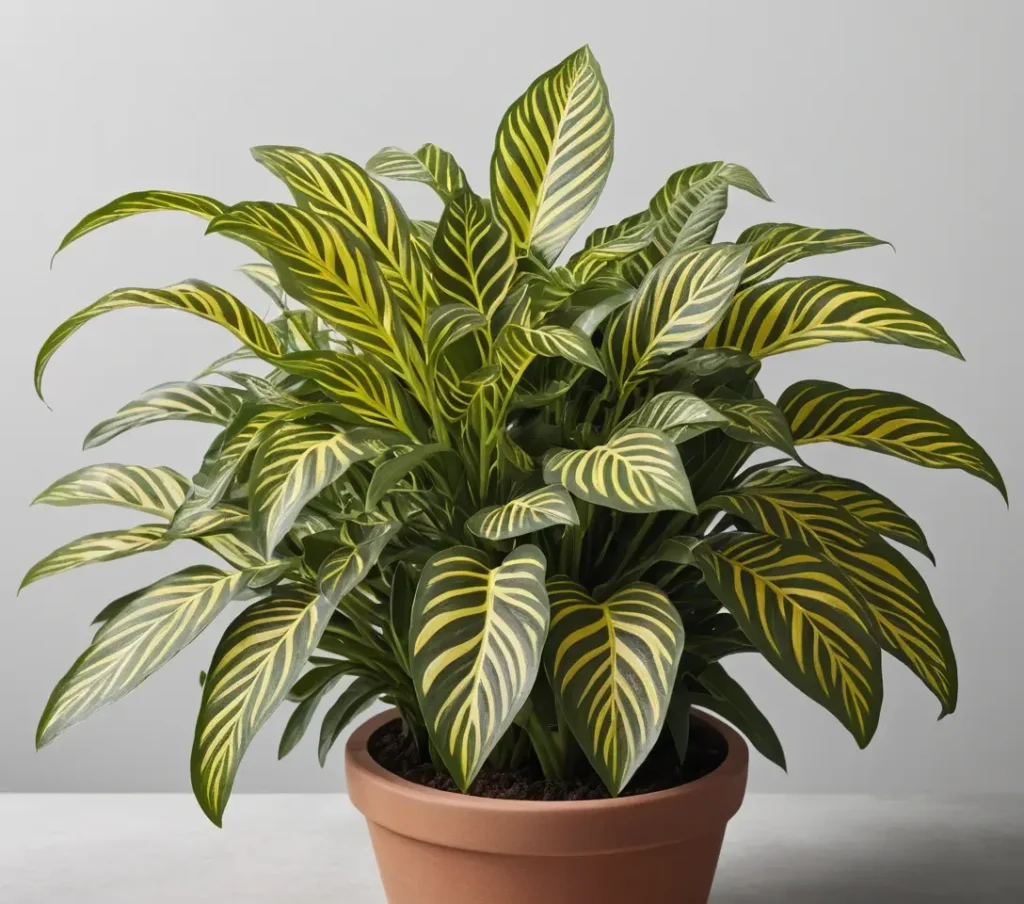Introduction
Want a houseplant that turns heads with its wild beauty? Meet the Zebra Plant a showstopper with glossy green leaves slashed with bold, creamy-white stripes. This tropical gem doesn’t just sit quietly in a corner; it demands attention and sparks conversations.
The Zebra Plant, scientifically known as Aphelandra squarrosa, is a tropical native of Brazil, Mexico, and South America. Its striking foliage marked with zebra-like stripes makes it a favorite among indoor plant lovers. Unlike common leafy greens, this plant combines drama with elegance, thriving in warm, humid environments reminiscent of its rainforest origins.
While its looks are undeniably captivating, the Zebra Plant isn’t just a pretty face. It’s a rewarding challenge for plant enthusiasts eager to hone their skills. With the right care, it can even produce golden-yellow flower spikes, adding a rare burst of color to your indoor jungle.
What You’ll Learn:
In this guide, you’ll discover:
- Care essentials: Light, water, and soil needs for vibrant leaves.
- Pro tips: Pruning tricks to encourage bushier growth.
- Troubleshooting: Fixes for yellowing leaves, pests, and more.
- Propagation: How to grow new plants from cuttings.
- Key considerations: Is this the right plant for your home?
Whether you’re a first-time owner or a seasoned gardener, you’ll walk away with the tools to keep your Zebra Plant thriving. Let’s dive in!
Unveiling the Beauty: What Makes the Zebra Plant So Captivating?

A Striking Visual Masterpiece
The Zebra Plant (Apheledra squarrosa) earns its name from the bold, white or silvery veins that streak across its deep green leaves like nature’s own brushstrokes. Each glossy, oval-shaped leaf can grow up to 9 inches long, with a sharp, pointed tip that adds to its dramatic flair. Indoors, this tropical beauty typically reaches 1–2 feet tall, making it a compact yet eye-catching addition to shelves or tabletops.
When the Zebra Plant Blooms
While its striped leaves are the main attraction, this plant can surprise you with blooms under the right care. In summer, it sends up tall spikes topped with bright yellow bracts that cradle tiny, delicate white flowers. Though the flowers themselves last only a few days, the bracts remain vibrant for weeks, adding a sunny pop of color to your space. To trigger blooming, provide consistent moisture and bright, indirect light proof you’ve nailed its care routine!
Botanical Backstory
The Zebra Plant belongs to the Acanthaceae family, a group known for showy foliage and tropical species like nerve plants and shrimp plants. Its scientific name, Aphelandra squarrosa, hints at its structured growth: “squarrosa” refers to the plant’s slightly upright, overlapping leaves.
Quick Facts at a Glance
- Leaf pattern: White stripes on dark green, glossy leaves.
- Mature size: 1–2 feet tall indoors.
- Flower features: Yellow bracts with short-lived white blooms.
- Blooming season: Summer, with proper care.
Why It Stands Out
Unlike many foliage-focused houseplants, the Zebra Plant offers dual rewards: year-round visual interest from its stripes and the occasional thrill of blooms. Just remember those flowers are a bonus, not a guarantee. Focus on keeping the leaves healthy, and let any blooms be a delightful surprise.
Next Up: Ready to learn how to keep those stripes vibrant? Let’s explore the essentials of Zebra Plant care.
Thriving Stripes: Your Step-by-Step Guide to Zebra Plant Care

Light Requirements
The Zebra Plant thrives in bright indirect light, think filtered sunlight similar to what it receives under a rainforest canopy. Place it near an east-facing window or 2–3 feet away from a south- or west-facing window with sheer curtains. Direct sun scorches its leaves, causing brown patches, while too little light leads to faded stripes and fewer blooms.
Pro Tip: Rotate the plant weekly to ensure even growth.
Watering
Watering is where many owners go wrong. Follow these rules:
- Check the soil: Stick your finger 1 inch deep. Water only if it feels dry.
- Soak thoroughly: Water until it drains from the pot’s bottom, then empty the saucer to prevent root rot.
- Seasonal adjustments: Water every 7–10 days in summer, every 2–3 weeks in winter.
Use room-temperature rainwater or filtered water to avoid mineral buildup in the soil.
Humidity
Zebra Plants crave humidity (aim for 60–70%). Boost moisture levels with:
- Pebble trays: Fill a tray with water and stones; place the pot on top.
- Grouping plants: Cluster humidity-loving plants together.
- Humidifiers: Set to 60% near the plant.
Low humidity causes crispy brown leaf edges. Avoid misting if your home is prone to fungal issues.
Soil
Use well-draining soil to prevent soggy roots. Mix:
- 2 parts peat-based potting soil
- 1 part perlite or orchid bark
- A handful of compost for nutrients
Repot every 2–3 years in spring if roots crowd the pot.
Temperature
Keep temperatures steady between 65°F and 80°F. Avoid cold drafts (near AC vents) and sudden drops below 60°F, which can trigger leaf drop.
Fertilizing
Feed during active growth (spring/summer):
- Use a balanced liquid fertilizer (10-10-10) diluted to half strength.
- Apply every 4–6 weeks.
- Stop feeding in fall and winter.
Warning:
Over-fertilizing causes salt buildup, leading to leaf burn. Flush the soil with water every 3 months to prevent this.
Quick Care Cheat Sheet
| Factor | Guideline |
|---|---|
| Light | Bright indirect light |
| Water | When top 1″ of soil is dry |
| Humidity | 60–70% (use a pebble tray) |
| Soil | Peat-based + perlite |
| Temperature | 65°F–80°F |
| Fertilizer | Half-strength, spring/summer only |
What’s Next?
Now that you’ve mastered the basics, let’s tackle pruning techniques to keep your Zebra Plant lush and full.
Keeping Your Stripes Sharp: Pruning and General Maintenance

Why Prune Your Zebra Plant?
Pruning isn’t just about aesthetics, it’s key to a healthier, fuller plant. Regular trimming:
- Encourages bushier growth by stimulating new branches at cut points.
- Removes dead or yellowing leaves that drain energy from healthy foliage.
- Prevents legginess, keeping the plant compact and lush.
How to Prune Like a Pro
- Timing: Prune in early spring or right after flowering (if it blooms). Avoid winter, when growth slows.
- Tools: Use sharp, sterilized pruning shears. Wipe blades with rubbing alcohol to prevent disease spread.
- Technique:
- Cut above a leaf node (the bump where leaves grow from the stem).
- Angle cuts downward to avoid water pooling on the wound.
- Remove thin, weak stems first to redirect energy to stronger growth.
Tip: Save healthy cuttings for propagation (more on that in Section 6!).
General Maintenance Tips
- Clean the leaves: Dust blocks light absorption. Wipe leaves monthly with a damp cloth. Avoid leaf shine products they clog pores.
- Check for pests: Inspect under leaves and along stems for spider mites or aphids. Treat infestations early with insecticidal soap.
- Rotate weekly: Ensure even light exposure to prevent lopsided growth.
Quick Maintenance Checklist
| Task | Frequency |
|---|---|
| Leaf cleaning | Monthly |
| Pest inspection | Every 2 weeks |
| Pruning | 1–2 times per year |
| Tool sterilization | Before/after each use |
What’s Next?
Even with perfect care, issues can pop up. Let’s troubleshoot common Zebra Plant problems in Section 5.
SOS for Stripes: Addressing Common Zebra Plant Issues
Yellowing Leaves
Yellow leaves signal distress. Here’s how to diagnose and fix the problem:
- Overwatering: Soggy soil + yellow leaves = root rot. Let soil dry completely, trim black roots, and repot in fresh, well-draining mix.
- Underwatering: Crispy edges with yellowing? Soak the pot in water for 10 minutes, then resume weekly watering.
- Low light: Pale yellow leaves mean more indirect light is needed. Move closer to a window.
- Nutrient deficiency: Older leaves turning yellow? Apply diluted balanced fertilizer every 4 weeks in spring/summer.
Brown Leaf Tips
Dry, brown tips scream low humidity. Fix it fast:
- Place the plant on a pebble tray filled with water.
- Run a humidifier nearby (60% humidity ideal).
- Avoid misting if fungal issues are a concern.
Dropping Leaves
Sudden leaf drop is often stress-related:
- Environmental shock: Caused by drafts, repotting, or moving the plant. Keep it in a stable location.
- Overwatering: Leaves drop with mushy stems. Reduce watering and improve drainage.
- Underwatering: Leaves wilt, then fall. Water deeply and adjust your schedule.
Pest Infestations
Aphids (tiny green bugs) and mealybugs (cotton-like clusters) love Zebra Plants. Act quickly:
- Natural fix: Wipe leaves with 70% rubbing alcohol using a cotton swab.
- Spray treatment: Apply insecticidal soap or neem oil weekly for 3 weeks.
- Isolate the plant to prevent pests from spreading.
Root Rot
Caused by overwatering or poor drainage:
- Symptoms: Foul odor, black/mushy roots, wilted leaves.
- Solution:
- Remove the plant, trim rotten roots with sterile scissors.
- Repot in fresh, well-draining soil.
- Water sparingly for 2–3 weeks.
Quick Troubleshooting Guide
| Issue | Cause | Solution |
|---|---|---|
| Yellow leaves | Overwatering | Dry soil, repot, trim roots |
| Brown tips | Low humidity | Pebble tray, humidifier |
| Leaf drop | Environmental stress | Stabilize location, check water |
| Sticky residue | Aphids/mealybugs | Neem oil, insecticidal soap |
| Mushy stems | Root rot | Repot, reduce watering |
Prevention Is Key
- Check soil moisture weekly with your finger.
- Keep humidity above 50%.
- Inspect leaves during cleaning for early pest signs.
What’s Next?
Ready to multiply your Zebra Plant? Let’s explore propagation in Section 6!
Multiply the Stripes: How to Propagate Your Zebra Plant
Why Stem Cuttings Work Best
Propagating your Zebra Plant through stem cuttings is simple and effective. This method leverages the plant’s natural ability to grow roots from nodes the small bumps along its stems. Spring or early summer is ideal, as the plant’s active growth phase speeds up root development.
Step-by-Step Propagation Guide
Select a Healthy Stem:
- Choose a stem with 3–4 leaves and no signs of pests or damage.
- Ensure it has at least one visible node near the base.
Make the Cut:
- Use sterilized pruning shears to cut below a node at a 45-degree angle.
- Aim for a 4–6 inch cutting.
Prepare the Cutting:
- Remove the lower leaves to expose the node.
- Dip the cut end in rooting hormone (optional but recommended for faster rooting).
Plant the Cutting:
- Fill a small pot with a moist mix of peat moss and perlite (2:1 ratio).
- Insert the cutting 1–2 inches deep, ensuring the node is buried.
Create a Humid Environment:
- Cover the pot with a clear plastic bag or place it in a propagation tray.
- Keep it in bright indirect light at 70–75°F.
Monitor and Wait:
- Open the bag for 10 minutes daily to prevent mold.
- Roots typically form in 4–6 weeks. Check by gently tugging the cutting if it resists, roots have developed.
Transplant:
- Move the rooted cutting to a 4-inch pot with standard Zebra Plant soil.
- Care for it like a mature plant (refer to Section 3).
Alternative Methods
While stem cuttings are most reliable, you can also:
- Root in Water: Place cuttings in a glass of water, changing it weekly. Transplant to soil once roots reach 2 inches.
- Divide Mature Plants: Rarely possible, as Zebra Plants seldom produce offshoots.
Quick Propagation Checklist
| Step | Key Tip |
|---|---|
| Stem selection | Healthy, pest-free, 4–6 inches long |
| Cutting preparation | Remove lower leaves, use rooting hormone |
| Planting | Bury node in peat-perlite mix |
| Aftercare | Maintain humidity, avoid direct sun |
Troubleshooting Propagation
- Wilting cutting: Increase humidity or reduce light exposure.
- No roots after 8 weeks: Discard and try a new cutting.
- Yellow leaves: Overwatering lets the soil dry slightly between waterings.
Why Propagate?
Propagation lets you expand your collection or share this striking plant with friends. Plus, nurturing and cutting into a thriving Zebra Plant is deeply rewarding!
Next Up: Wondering if the Zebra Plant suits your lifestyle? Let’s weigh the pros and cons in Section 7.
Should You Welcome a Zebra Plant into Your Home?
The Zebra Plant at a Glance
Before adopting this striped beauty, let’s recap its core needs:
- Light: Bright indirect sunlight (no harsh rays).
- Humidity: 60–70% for happy leaves.
- Water: Only when the top inch of soil dries out.
- Attention: Regular pruning and pest checks.
Why It’s Worth the Effort
- Stunning Visual Appeal: Few plants rival its dramatic stripes and glossy foliage. It’s a living art piece.
- Air-Purifying Qualities: Like most houseplants, it helps filter indoor air pollutants.
- Gardener’s Pride: Successfully nurturing a Zebra Plant to bloom feels like earning a green thumb badge of honor.
Think Before You Buy
Ask yourself:
- Can you provide bright light? North- or east-facing windows are ideal.
- Will you maintain humidity? Pebble trays or humidifiers are non-negotiable in dry climates.
- Do you enjoy a challenge? This plant rewards patience but won’t thrive on neglect.
Perfect For:
- Plant lovers seeking a striking centerpiece.
- Homes with consistent indoor temperatures.
- Gardeners are eager to level up their skills.
Not Ideal For:
- Frequent travelers who can’t water weekly.
- Low-light spaces without grow lights.
- Pet owners with curious cats/dogs (it’s mildly toxic).
Ready to Take the Leap?
If you’re up for the challenge, a Zebra Plant will transform your space with its wild elegance. Share your growing journey in the comments below. We’d love to hear your tips or answer questions!
Final Tip: Start with a young plant to learn its quirks before investing in a mature specimen.
What’s Next? Let’s wrap up with key takeaways in the Conclusion.
Conclusion: Enjoy the Beauty of Your Zebra Plant
The Zebra Plant, with its bold stripes and glossy leaves, is more than just a houseplant it’s a living masterpiece. Its striking appearance transforms any room into a tropical oasis, drawing admiration from everyone who sees it. By following the care steps in this guide, you’ll unlock its full potential, watching it thrive under your attentive care.
Consistency is key: Bright indirect light, balanced watering, and steady humidity keep those iconic stripes vibrant. While it demands a little effort, the rewards, like the rare golden blooms or the pride of a pest-free plant, make every moment worthwhile.
Plant care is a journey, not a race. Challenges like yellowing leaves or stubborn pests are opportunities to grow as a gardener. Each new leaf is a small victory, a sign that your Zebra Plant is thriving because of you.
So, whether you’re a first-time plant parent or a seasoned green thumb, let this Zebra Plant remind you of nature’s resilience and beauty. Share your progress, celebrate its quirks, and enjoy the calm it brings to your space. After all, few things are as satisfying as nurturing a living work of art.
Final Thought: Your Zebra Plant isn’t just surviving, it’s flourishing, thanks to your care. Keep learning, stay curious, and let those stripes shine!
Your Next Step: Revisit the care guide anytime you need a refresher, and don’t forget to check the FAQs below for quick answers!
This conclusion ties together the guide’s themes while inspiring confidence and joy in the reader’s plant care journey.
FAQs: Quick Answers to Common Zebra Plant Questions
How long do Zebra Plants live?
With proper care, they can thrive for 5–10 years. Their lifespan depends on consistent light, humidity, and avoiding root rot.
Why won’t my Zebra Plant bloom?
Blooms require bright indirect light and slightly root-bound conditions. Ensure it gets 6–8 hours of filtered light daily and avoid over-fertilizing.
Can I use tap water for my Zebra Plant?
Tap water is fine if left out overnight to evaporate chlorine. For best results, use filtered or rainwater to prevent mineral buildup in the soil.
How often should I repot my Zebra Plant?
Repot every 2–3 years in spring. Choose a pot 1–2 inches larger to prevent overwatering.
Are Zebra Plants safe for pets?
No. They’re mildly toxic to cats and dogs. Keep them out of reach to avoid stomach irritation if ingested.
Why are my Zebra Plant’s leaves curling?
Curling leaves often signal low humidity or underwatering. Boost moisture with a pebble tray and check soil dryness weekly.
Can I grow a Zebra Plant in low light?
It will survive but not thrive. Without bright indirect light, stripes fade and growth slows. Use a grow light if natural light is limited
How do I revive a drooping Zebra Plant?
Check the soil:
Soggy? Let it dry completely and trim rotten roots.
Bone-dry? Soak the pot in water for 10 minutes.
Do Zebra Plants go dormant?
Growth slows in winter. Reduce watering and stop fertilizing until spring.
What’s the best way to propagate a Zebra Plant?
Stem cuttings in spring/summer have the highest success rate. Use rooting hormone and keep cuttings warm and humid.
Have More Questions?
Drop them in the comments below! Share your Zebra Plant stories or tips, we’d love to hear from you.
